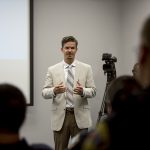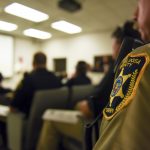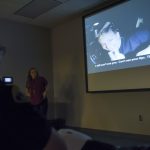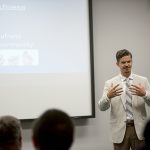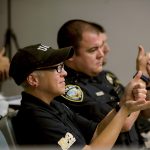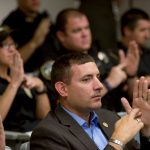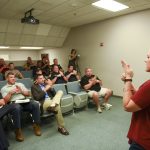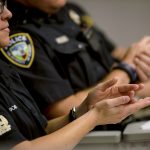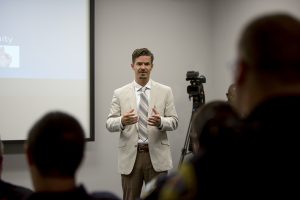
TUSCALOOSA, Ala. — As nearly 20 law enforcement officers from across four different agencies sat in a theatre-style room Tuesday at The University of Alabama, all but one revealed an interaction that surprised workshop organizers Dr. Darrin Griffin and Erin Powell.
Nearly all of the officers said they’d had a previous interaction with a person who was deaf or hard of hearing while on duty.
“Ninety percent of hearing people meet a deaf person for the first time when it’s their own child who becomes deaf,” said Griffin, assistant professor of communication studies at UA and advocate for the deaf and hard of hearing. “That’s a pretty striking statistic.”
While officers provided anecdotes about their experiences, Griffin and Powell, who organized and held the workshop for interacting with members of the Deaf community, were able to provide context to some of the misunderstandings during those interactions, an overview of civil rights as they relate to people who are deaf or hard of hearing, and teach the officers 10 basic signs that could be applied during future interactions.
“When I first started in law enforcement, about a month after I got out of the training car, I ran into a person on a traffic stop who was deaf,” said Lachlan Chronister, an officer in the Tuscaloosa Police Department. “And, it’s stuck with me how little ability I had to communicate with that person. So much of our job is communication. People think it’s ‘cops and robbers,’ but really it’s about getting our messages across to another person. I’m now in a position in my department where I train new officers and come up with new ideas.”
Officers learned basic signs previously recommended by people who are deaf or hard of hearing, like “I’m deaf” or “step out of the car.” Officers also learned how the nuances of communicating with deaf citizens can either enhance or weaken the interaction, depending on the officer’s knowledge.
For instance, when an officer approaches a car during a traffic stop and shines their flashlight at the driver’s side window, a deaf person’s reaction may be interpreted as panicking, but, not because they’re concealing anything, but because the bright light prevents them from seeing – the channel of communication for the Deaf.
Still, reading lips might not be enough for a deaf person to communicate during that interaction. Griffin said that only one-third of spoken word can be understood through lip-reading. Additionally, close to 50 percent of deaf people have another disability that may further complicate communication with an officer.
Powell, an interpreter and adjunct professor who teaches American Sign Language in UA’s Honors College, said she’s only been approached once about providing training, in part because people and organizations don’t know where to find resources.
“I feel like the Deaf community in Tuscaloosa is small and doesn’t have a lot of exposure,” Powell said. “We’re trying to work on that, to establish their rights in the community and that they’re known. On our end, it’s about making it known that we have the resources and actively spreading them out into the community.”
The workshop was prompted, in part, after a recent incident in which a man in North Carolina was shot and killed by a state trooper after a traffic stop and brief chase. Powell and Griffin discussed six different incidents Tuesday in which citizens were abused or mistreated by police, leading to civil suits.
“The number one concern is civil rights – that someone is not hurt and that their rights are respected,” Griffin said. “The second thing is the legality of it. If you were to look into the lawsuits over treatment by law enforcement, there’s a lot of money being spent to rectify, and reparations because of incidents of the Deaf being abused or killed by law enforcement.”
Contact
David Miller, UA Media Relations, 205/348-0825, dcmiller2@ur.ua.edu
Source
Dr. Darrin Griffin, 205/632-0777, djgriffin1@ua.edu

